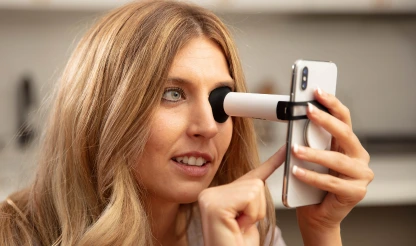Refraction Technology
Virtualization has revolutionized our lives, enabling us to bank, shop, learn, socialize, and even buy cars from the comfort of our homes. Despite the dramatic digitization of our lives, eye care remains largely untouched by this transformation.
There is a crisis in eye care due to an aging population, an increase in eye disease and visual impairment, and an eye care provider shortage. The traditional model of eye care with an in-office exam is not sustainable, and it is very expensive. Technology can provide the solution to these problems. Eye care must transition to a virtual digitized format just like all of the other digital transformations in our lives.
It is time to change the model of eye care.
Imagine low-cost small portable devices that use your smartphone to test your eyes. These devices can check your vision, color vision, contrast sensitivity, and your need for vision correction. Using these technologies from the comfort of your home, you will have an accurate measure of your vision and eye health within minutes. These technologies are connected to a Telehealth platform so that you can obtain a glasses or contact lens prescription, order glasses and contact lenses, or meet with an eye care provider digitally.
This is not science fiction as the technologies exists.
EyeQue has created all of the devices described above. EyeQue has also developed the world’s only AI based refraction measurement device that combines the power of an autorefractor (the machine that automatically measures your eyes) and a phoropter (the device that the eye doctor uses to check your prescription with your input). These devices are so small that they fit in the palm of your hand, and are operated at home!
EyeQue has also developed a state of the art, HIPPA compliant, Amazon Web Services protected Telehealth platform to collect the data from its devices so that they can be reviewed by an eye care provider and so that you can follow your eye health over time.
Backed by a decade of innovation, 35 patents, and industry-leading optics expertise, EyeQue is a brand you can trust.
EyeQue – join the journey!
*https://modernod.com/articles/2019-mar/the-future-of-optometry-in-america. The author calculated the projections using data from the American Optometric Association’s 2014 Workforce Study and the Association of American Medical Colleges & Bureau of Health Professions Report 2002-2003.
Quick Links
Factors Impacting Vision
Many conditions may impact your vision. This is why EyeQue’s vision screening and vision monitoring tools are important.
These tools are important for your eye health, guiding your doctor and you to be sure that you get the most accurate and effective care.
Eye Diseases
- Refractive Errors
Myopia (Nearsightedness), Hyperopia (Farsightedness), and Astigmatism
Presbyopia – need for near vision correction - Amblyopia (Lazy Eye)
- Color Vision Deficiency
- Myopia Management-treating and following myopia changes
- Post-surgical vision changes – after cataract surgery or other refractive surgery
- Keratoconus – cone like shape of the cornea
- Corneal changes – infections, dystrophies, or degenerations
- Cataracts-clouding of the natural lens of the eye
- Glaucoma- high eye pressure from either open angle or narrow angle changes
- Dry Eye Disease and Management (DED)
- Inflammation and Infections of the eye – uveitis and all types of infectious organisms
- Macular Degeneration (AMD)-dry or wet
- Diabetic Retinopathy (DR)
- Retinal Detachment (RD)
- Retinitis Pigmentosa- an inherited retinal disorder that may lead to blindness
- And many other eye conditions
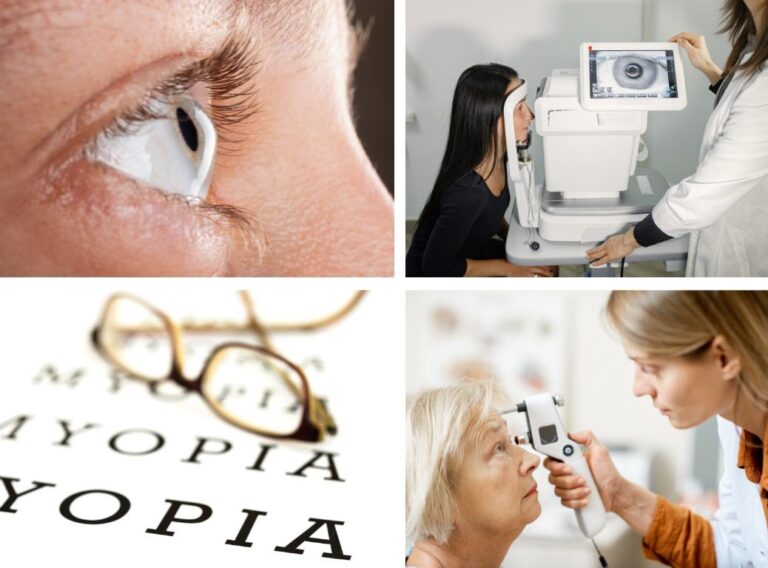
Systemic Diseases
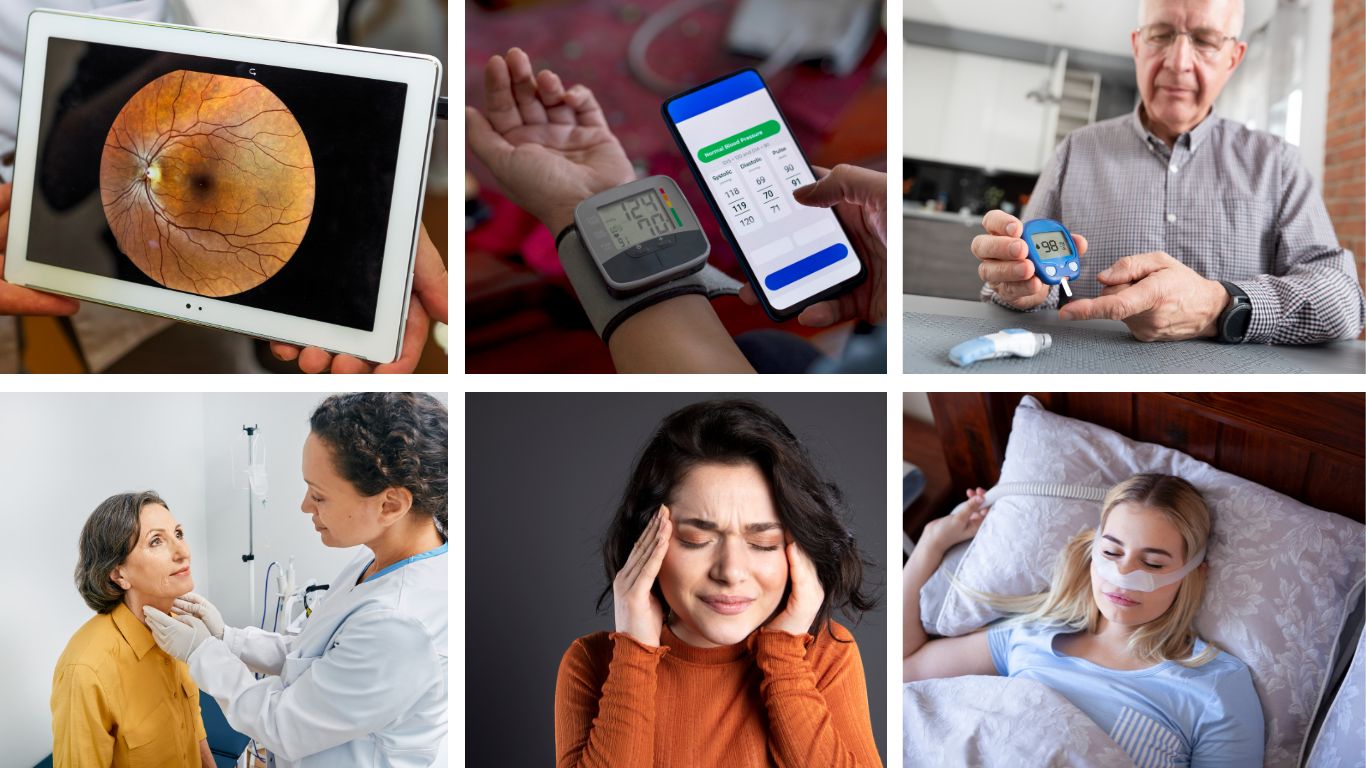
Environmental and Lifestyle Factors

It’s important to note that this list is not exhaustive, and many conditions can have overlapping effects on vision. Regular vision screening, eye health check-ups, and prompt attention to changes in vision are crucial for maintaining eye health. If you experience any vision changes or discomfort, it’s recommended to consult with an eye care professional for a comprehensive examination.
Vision Screening
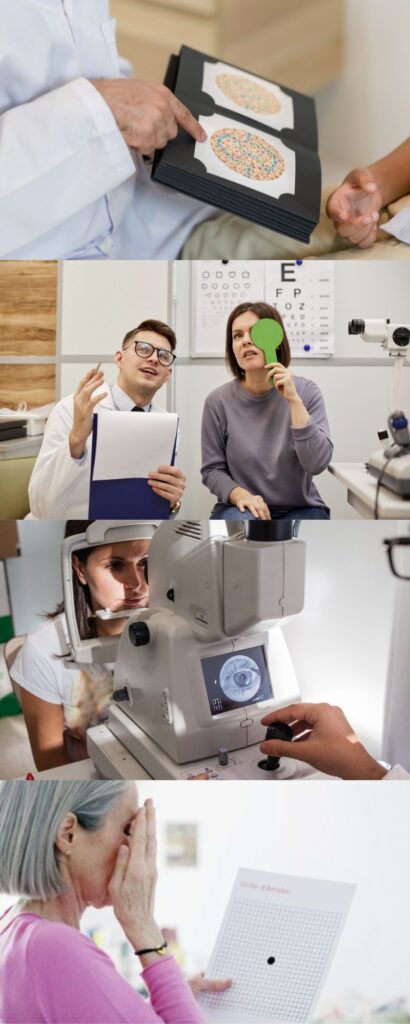
EyeQue is a global leader in digital eye health products capable of screening for vision metrics. This document explains what vision metrics and vision screening are and why they are important.
A “Vision Metric” is a measurable parameter crucial for monitoring visual function and eye health, including visual acuity, contrast sensitivity, color vision, stereoscopic vision, etc. It is widely used in research, clinical practice, and technological developments; vision metrics aid in understanding, diagnosing, and managing various eye conditions.
“Vision Screening” is a holistic approach health professionals use to assess visual function and eye health, identifying key metrics that offer valuable insights into the visual system’s condition. This approach aims to efficiently detect, monitor, and manage eye conditions by evaluating a range of vision metrics.
- Visual Acuity: Quantifies the sharpness and clarity of vision, particularly in identifying fine details
- Contrast Sensitivity: The ability to distinguish between different shades of light and dark.
- Color Vision: Assesses the perception and differentiation of colors, detecting anomalies and deficiencies.
- Central Retinal Vision: Evaluates the health and function of the macula for central visual acuity.
- Peripheral Vision: Examines the ability to see objects and movement outside the central visual field.
- Depth Perception: Assesses stereopsis and the perception of relative distance.
- Night Vision: Measures the ability to see in low-light conditions, identifying potential issues.
- Visual Field Testing: Examines the vision scope, including central and peripheral areas.
Just like regularly checking your blood pressure or taking your temperature, keeping an eye on your eye health is important. Here’s how early detection with vision marker screening can benefit you:
- Catch problems early: Regular screenings can help identify eye conditions early on, when treatment is often most effective.
- Manage eye diseases: If you have a condition like Diabetes, Glaucoma, or Macular Degeneration, regular monitoring can help track its progression and ensure you get the right care on time.
- Protect your future vision: Early detection can help prevent vision loss from many eye conditions.
- See your best: By keeping your eye health on track, you can maintain sharp, clear vision and enjoy all the beauty the world has to offer.
- Take charge of your health: Regular eye care empowers you to be proactive about your vision and overall health.
At EyeQue, we’re all about taking charge of your eye health. With our digital health devices, we offer Vision Screening, a vital step in proactive vision care customized to meet your unique eye health requirements.
Our products offer cutting-edge Vision Screening, empowering you with early detection and personalized care to ensure your vision stays in top shape. Be a champion of proactive vision care and experience the difference with EyeQue.

Frequent Vision Monitoring
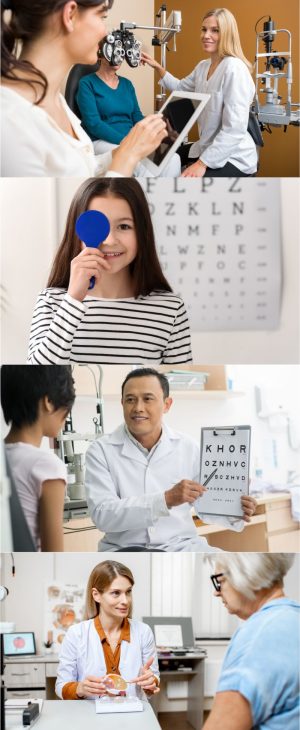
EyeQue stands out with a revolutionary digital health product line, leveraging advanced technology and boasting a robust pipeline of products integrating Artificial Intelligence.
With vision marker screening capabilities, our products enable early disease detection and progress monitoring. This proactive approach enhances treatment outcomes, reduces follow-up costs, and aligns seamlessly with the value-based care model. Patients and providers benefit from timely interventions, contributing to a more effective and efficient healthcare paradigm.
EyeQue products provide Frequent Vision Monitoring (FVM), an innovative and dynamic approach to eye health, embracing technology to provide frequent and personalized assessments of visual function. It is similar to the widely adopted Continuous Glucose Monitoring (CGM) used in diabetes management. This concept goes beyond traditional sporadic screenings, embracing technology to provide individuals with a proactive and personalized strategy for maintaining optimal vision and enhancing healthcare providers’ delivery capabilities.
- Track your vision over time: Just like tracking your steps with a fitness tracker, EyeQue lets you monitor your vision health regularly. This creates a dynamic profile, helping you and your eye doctor identify any changes early on.
- Smart Technology in your hand: Our easy-to-use devices with smart technology work seamlessly with your smartphone or other devices. This allows you to conveniently monitor your vision from the comfort of your home.
- Get personalized alerts: EyeQue can notify you of any potential changes in your vision health, so you can address them promptly with your eye doctor.
- Become an eye health pro: We provide educational resources to help you understand what vision markers mean. This empowers you to be an active participant in taking care of your eyes.
- Take charge of your eye health: EyeQue helps you understand your vision health better, so you can make informed decisions about your lifestyle, treatments, and preventive measures. This knowledge puts you in the driver’s seat of your eye care.
- See clearly, live fully: By keeping your vision sharp and healthy, you can enjoy all the little and big things in life without limitations. EyeQue empowers you to maintain optimal vision for a better quality of life.
EyeQue puts eye care at your fingertips with innovative technology. Our products can help you catch eye problems early by using Vision Screening. By letting you easily track your vision over time, we can help you and your eye doctor identify any changes early on. This can lead to better treatment outcomes, fewer doctor visits, and a more cost-effective approach to eye health. This technology is like a continuous glucose monitor (CGM) but here we are frequently monitoring vision markers of your eyes!
Think of EyeQue as your personal eye health tracker. We offer frequent vision monitoring (FVM) , which allows you to easily monitor your vision health at home, just as you would track your steps with a fitness tracker. This proactive approach empowers you to take charge of your eye health and allows your eye doctor to provide better care.
